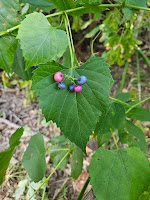Latin name: Melothria pendula
Common name: Creeping cucumber
Season: Summer
Edible: Unripe fruit ONLY
Flavor: Good
Medicinal value: Unknown, but see notes below
Nutritional value: Carbohydrates, fiber, vitamin C and a surprising amount of protein
Identification difficulty: Beginner
Note on edibility: Only unripe fruits, which are light to medium green and hard should be eaten. Once even slightly soft or dark green, these fruits become dangerous laxatives. Some people, myself included, are highly sensitive to the laxative effects of this plant, even when the fruit is very unripe. I recommend only trying 1-3 at first, until you discover how you react.
This charming little viny plant is Melothria pendula, commonly known as the creeping cucumber or the Guadalupe cucumber. The common names come from the similar appearance of the plant to cultivated cucumbers, although in miniature. Despite the names and the similar appearance, creeping cucumber is only distantly related to its cultivated cousins; they are both in the Cucurbitaceae family.
The Cucurbitaceae family, or the gourd family, contains most melons, gourds, squashes and cucumbers. Cultivated cucumbers are part of the Benincaseae tribe (which also contains watermelons) and the Cucumis genus, but creeping cucumbers are not part of that tribe.
What creeping cucumber does have in common with cucumbers and the white rind of watermelons is the taste.
 |
| Creeping cucumber flower and young leaves |
Creeping cucumber range
In the United States, creeping cucumber is found in the southeast states only, from Virginia south to Florida, and west as far as Kansas, Oklahoma and Texas. In rare occurrences it has been found in Pennsylvania, though be sure to really check your identification that far north.
Outside of the USA, this plant can be found in Mexico, Central America, including the islands of the West Indies, and parts of South America. I am not sure how far south it extends. It has also been found tropical areas of the far east, such as Malaysia, Sumatra, the Philippines, and Bali. It is likely introduced to those areas.
As always, this post is intended for readers in the United States, and I cannot account for potential look-a-likes in other countries, as I would not be aware of them.
Creeping cucumber season
In the southern USA, you may begin to find fruit as early as June, and fruiting will continue throughout the summer, until the days start to shorten in September. In the northern part of the plant's range, you can't expect fruit before July.
Creeping cucumber identification
 |
| Creeping cucumber leaves |
Creeping cucumber stem, vine and leaf features
Creeping cucumber is a tiny vine, only about 3-4mm in diameter, though the fruit-bearing tendrils will be thinner. The image to the right gives you a pretty good idea of the thickness of the vines as compared to my fingers.
As shown in the photo above, the thin leaves are palmate, which is to say that the leaf veins all come from a single point where they connect to the stem, like the fronds on a palm tree connect to the trunk.
They have 3 lobes when young, but 5 when mature, though 2 lobes will always be rather subtle. I have numbered them to make them easier to see in the photo above.
As creeping cucumber is a vine, it can't support its own weight and creep over woody plants and even young trees, often forming dense mats. (See below.) Plants covered this way will die.
The vine attaches to other plants via delicate tendrils shown here. The leaves, stems, vines and tendrils are all poisonous and should not be eaten.
 |
| Creeping cucumber tendrils |
 |
| A dense mat of creeping cucumber vines, covering other plants and underbrush. |
Flowers
Creeping cucumber flowers are bright yellow and have 5 petals. Each petal is notched at the end.
The flowers are dainty, around 7mm in diameter, or slightly larger than a pencil eraser.
The flowers hang off pendules (from which the plant gets the second part of its Latin name: pendula), at the node where two opposite leaves meet on the vine. This means that the flowers, and the fruit they turn into, will often be hidden under the leaves.
 |
| This unripe fruit is at the perfect stage for eating |
Fruit
ONLY UNRIPE FRUIT SHOULD BE EATEN.
Unripe fruit is light green, speckled, and firm or hard.
Creeping cucumber fruits are ovate or occasionally teardrop shaped.
They are small, not more than an inch in length and half to 3/4 of an inch in diameter. They can be smaller, around the size of a jelly bean.
The one shown to the right is at the perfect stage for eating. Once they darken and soften, the spots will fade and the insides will start to become gelatinous (see below). They will eventually become near-black.
 |
| These fruits are too mature and will have a dangerous laxative effect if consumed |
Ripe fruits are powerful laxatives, eating them will result in the urgent need to painfully defecate and can potentially lead to dangerous dehydration and even muscle spasms.







No comments:
Post a Comment